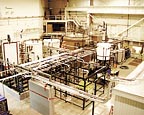
Electrodialysis depends on the following general principles:
- Most salts dissolved in water are ionic, being positively (cationic) or negatively (anionic) charged.
- These ions are attracted to electrodes with an opposite electric charge.
- Membranes can be constructed to permit selective passage of either anions or cations.
The dissolved ionic constituents in a saline solution - such as Na+, Ca2+, and CO32- - are dispersed in water, effectively neutralizing their individual charges. When electrodes connected to an outside source of direct current (a battery, for example) are placed in a container of saline water, electrical current is carried through the solution, with the ions tending to migrate to the electrode with the opposite charge.
For these phenomena to desalinate water, membranes that will allow either cations or anions (but not both) to pass are placed between a pair of electrodes. These membranes are arranged alternately with an anion-selective membrane followed by a cation-selective membrane. A spacer sheet that permits water to flow along the face of the membrane is placed between each pair of membranes.
One spacer provides a channel that carries feed (and product) water, while the next carries brine. As the electrodes are charged and saline feed water flows along the product water spacer at right angles to the electrodes, the anions in the water are attracted and diverted towards the positive electrode. This dilutes the salt content of the water in the product water channel. The anions pass through the anion-selective membrane, but cannot pass any farther than the cation-selective membrane, which blocks its path and traps the anion in the brine. Similarly, cations under the influence of the negative electrode move in the opposite direction through the cation-selective membrane to the concentrate channel on the other side. Here, the cations are trapped because the next membrane is anion-selective and prevents further movement towards the electrode.
By this arrangement, concentrated and diluted solutions are created in the spaces between the alternating membranes. These spaces, bounded by two membranes (one anionic and the other cationic) are called cells. The cell pair consists of two cells, one from which the ions migrated (the dilute cell for the product water) and the other in which the ions concentrate (the concentrate cell for the brine stream).
The basic electrodialysis unit consists of several hundred cell pairs bound together with electrodes on the outside and is referred to as a membrane stack. Feed water passes simultaneously in parallel paths through all of the cells to provide a continuous flow of desalted water and brine to emerge from the stack. Depending on the design of the system, chemicals may be added to the streams in the stack to reduce the potential for scaling.
The raw feed water must be pre-treated to prevent materials that could harm the membranes or clog the narrow channels in the cells from entering the membrane stack. The feed water is circulated through the stack with a low-pressure pump with enough power to overcome the resistance of the water as it passes through the narrow passages. A rectifier generally is used to transform alternating current to the direct current supplied to the electrodes on the outside of the membrane stacks.
Post-treatment consists of stabilizing the water and preparing it for distribution. This post-treatment might consist of removing gases such as hydrogen sulfide and adjusting the pH.
In the early 1970s, an American company commercially introduced the electrodialysis reversal process (EDR) process for electrodialysis. An EDR unit operates on the same general principle as a standard electrodialysis plant except that both the product and the brine channels are identical in construction. At intervals of several times an hour, the polarity of the electrodes is reversed, and the flows are simultaneously switched so that the brine channel becomes the product water channel, and the product water channel becomes the brine channel. The result is that the ions are attracted in the opposite direction across the membrane stack.
Immediately following the reversal of polarity and flow, enough of the product water is dumped until the stack and lines are flushed out, and the desired water quality is restored. This flush takes about one or two minutes, and then the unit can resume producing water. The reversal process is useful in breaking up and flushing out scales, slimes and other deposits in the cells before they can build up and create a problem. Flushing allows the unit to operate with fewer pretreatment chemicals minimizes membrane fouling.
ND

Report Abusive Comment